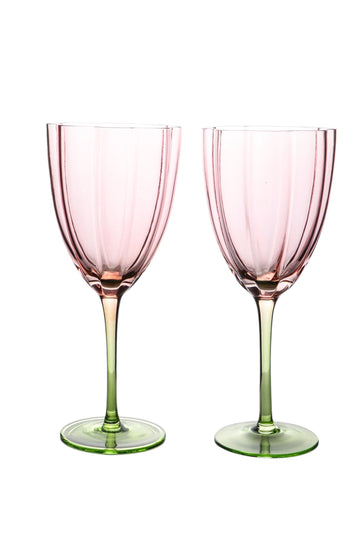Selecting wine glasses is as important as the glasses themselves; many people tend to drink water and other militia drinks in a common glass, not knowing that flavor and other qualities depend on it. Understanding the different types of wine glasses is essential in determining the special characteristics that they bring to each type of wines as well as lending an elegant touch to any dinner party or evening in.
The classic red wine glass family
Red wines therefore require large bowls that provide room for the wine to breathe intensively. The Bordeaux glass is the tall wide designated to Cabernet Sauvignon, Merlot and other full bodied wines. It has a tall design that blows concentrated aromatics toward the nose and a larger area that helps provide aeration. Finally we have the Burgundy glass which is used for wine such as Pinot Noir or light, delicate Gamay. A large, open throat mellow harshness down acidic notes and accommodated cherry or earthy tones a more narrow rim might not detect. The glassware also show, quite effectively, how each sort of glass hones, by controlling the contact of oxygen and the concentrations of vapor how there is actually any 1 solution for red wines.
Glassware Tailored to White and Rose Wines
Especially white wine is best served in a small bowl that keeps the wines at an appropriate warmth and intensifies the fruity notes of the berries. A traditional white wine glass has a smaller lip than that of a white wine glass to channel out the melon or citrus flavors towards the palette and its concave bowl shape to cool the wine. A slightly taller Chardonnay glass, with a larger bowl and more tapered top, is used to best glass oaky versions with the wine’s richer body and texture. Rosé finds acceptance in either the global, clear white wine glass or a combination of a tulip with retaining the floral notes without compromising on acidity. Each example demonstrates how the wine glasses and their utilities change relative to the varietal characteristics such as the acidity, aroma, and temperature.
Sparkling Wine From the Flute to the Tulip
Sparkling wine produces its subcategory in the types of wine glasses; let alone how it commemorates special occasions and moments. The traditional champagne glass is smaller and tall, which helps to maintain the C02 and move it up in visually appealing fashion. Yet today, most sommeliers speak more of a tulip-shaped sparkling glass. the central portion offers real estate to twirl in which to unleash candid (brioche, citrus) notes and balances that with the help of a more slender lip enabling bead retention. Depending on the type chosen, the volume floats whereas six to eight ounces is slightly lower than vampire wine glasses as carbonation and chills are fundamental to the tasting process. This goes to show why the average wine glass size is never generic but will be based on the technical requirements of a particular wine.
Dessert and Fortified Wine Considerations
Fortified wine, Sherry and Late Harvest whites finally show the world that sweet wines need own bowls as well. A small wine glass reduces exposure to oxygen, retains rose-like characteristics, and channels sweet juice to the very rear of the oral cavity, while the tip of the tongue experiences sweetness in lesser degrees. Grands Vins such as Tawny Port derive more depth from their contact time but CVPs’ increased alcohol levels require measured measures. small portions allow for greater control and do not leave you overwhelmed by the drink. This segment of the different types of wine glasses family shows how control or volume coupled with tapered rims can diminish intense aromas and high residual sugar to prolong the enjoyment without tiring out the palate.
Stemless Trends and Outdoor Viability
Stemless glasses have been acceptable as the concept of informal entertaining is on the rise. Wine purists also claim thatWs hand warmth raises temperature of wine but good stemless designs employ slightly thicker glass walls and there is an inward curvature near the brim. They are tougher, can be safely washed in a dishwasher, and are perfect for the patio or a picnic when the regular stems just topple over. However, the ‘less is more’ approach of stemless formats pertains to the characteristics of wine glass type ergonomics in general: bowl width, lip diameter, and overall height are still relevant to aromatics, even if there is a stem.
The Science of a Normal Size of the Wine Glass
Typically, a tasting glass ranges between 12 to 14 ounces, providing sufficient space for circumambulation without lending itself to dumpling pourage. Red wine bowls that are large often measure more than twenty ounces because the mechanisms cause the wine to breathe and uncongestion tannis to reveal its various aromas. Most white and sparkling wines are served in glasses which are between eight to twelve ounces because of the acidities and carbnation that are wanted in wines that have bubbles. Apart from honing one’s serving skills and presentation, the recognition of the regular wine glass size serves yet another purpose which is a shrinking sort of way of discouraging ove
Material Rim Finish and Weight are subtle factors with major impact
Many individuals pay much attention to shape, but the composition can improve or worsen the taste. For instance, lead free crystal provides a fine lip and renders better examination of ostensible gradation of colors as in aged reds. Machine blown glass is still an affordable option though the thickness yields greater success and sturdiness. A laser cut rim has a thin and sharp cut that produces uniform effect when serving wine while thick rims change the flow of wine when taken to the palate. Weight distribution in the stem also provides comfort during protracted dinners or tastings coupled with stem weight distribution. These production details typify how complex the category of wine glasses types and uses is.
How to Care for Your Wine Glass Investment
Maintenance makes work less complex and extends the durability of implements. Clean it with dish washing solution and warm water, and then let it dry on the upside of lint free cloth in order to prevent water stains. The cycles cause fine rims to tarnish over time, but hot ware machine blown glass should be okay on top shelf. The glasses have to be stored in an upright position to avoid damage to the rim while minor rough cleaning is done using microfiber material which eliminates fingerprints which distort both appearance and aroma of the product. A general car maintenance is the best way of maintaining even a basic collection and keep all wine glassware types in their best working condition.
Building a Versatile Starter Set
If you host parties and have limited space, it is wise to start your collection with two red glasses, two white wines, and two sparkling wines. It is a minimalistic kit for dinner starting from the salad and going through the wine and including the desert and it is flexible enough to fit the unexpected bottles. Acquire specialty bowls progressively as your tastes develop; a wider Burgundy glass for more New World Pinot Noir, or smaller Port monstrosities for chilly nights. For this reason, strategic acquisition means that your set grows as your taste does, without filling your glasses collection with unwanted duplicates at the cost of acquiring better ones.
Choosing the Right Glass for Every Pour
Paring the glass to the wine feels like the wine is a special occasion no matter how simple the day is. Accordingly, bowl width, rim diameter, and overall volume are aligned with the structure of the wine in the hand to provide an optimal dimension to enjoy optimal aroma expression, preserving temperature, and steering the taste towards the ideal palate.







